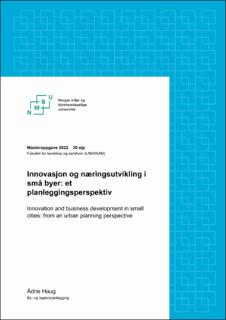| dc.contributor.advisor | Marino, Mina Di | |
| dc.contributor.advisor | Tenge, Gunnar | |
| dc.contributor.author | Haug, Ådne | |
| dc.coverage.spatial | Norway | en_US |
| dc.date.accessioned | 2023-03-07T08:23:22Z | |
| dc.date.available | 2023-03-07T08:23:22Z | |
| dc.date.issued | 2022 | |
| dc.identifier.uri | https://hdl.handle.net/11250/3056221 | |
| dc.description.abstract | Med dagens urbanisering og økende vekst i de store byene er det viktig å huske på at mange av landets innbyggere også bor i mindre byer, og har behov for gode arbeidsplasser og attraktiv byutvikling. Det er forsket lite på små byer, og enda mindre på næringsutvikling og innovasjon i små byer i sammenhengen med arealplanlegging. Hensikten med oppgaven er å belyse hvordan man kan planlegge for attraktiv næringslivsutvikling og innovasjon i små byer. Med dette som hensikt skal oppgaven undersøke om planlegging for dette krever andre metoder og strategier enn dagens praksis for å sørge for ønsket resultat.
Tematikken utforskes kvalitativt gjennom en casestudie av Brumunddal i Ringsaker kommune med fokus på en områdeplan som legger til rette for kunnskapsbasert næring og bymessig bebyggelse sentralt i byen. Casestudiet består av litteraturstudie, dokumentanalyse, semistrukturerte intervjuer og GIS- og stedsanalyse som vil belyse hvordan man bør planlegge for næringsutvikling og innovasjon i små byer, hvilke egenskaper Brumunddal har som sted, hvordan områdeplanen har lagt til rette for næringsutvikling og innovasjon, og hva som kunne vært gjort annerledes for å i større grad nå målet med planen.
Denne avhandlingen viser at Ringsaker kommune gjør mye riktig i sin arealplanlegging for næringsutvikling og innovasjon. Blant annet jobber kommunen helhetlig med attraktivitet, samhandler med grunneiere, er bevisste på samspillet mellom arealplanlegging og næringsutvikling, og har laget en fleksibel områdeplan. Litteraturstudiet og andre data fra avhandlingen viser at Ringsaker med fordel kan gjøre endringer og forbedringer som kan øke sannsynligheten for at områdeplanen og andre lignende planer blir gjennomført. Noen eksempler på dette er at kommunen bør utvikle nettverkene sine, bli mer bevisste på hybriditet og multifunksjonalitet, og ha mer konkrete strategier rundt hvem og hva de planlegger for.
Avhandlingens resultater bidrar til den akademiske debatten ved å gi konkrete svar på hvordan en småbykommune kan planlegge for næring og innovasjon gjennom arealplanlegging og strategier. En implikasjon for avhandlingen er at temaet er lite skrevet om, og oppgaven har derfor en omfattende tilnærming. Dette gjør avhandlingen desto mer nyttig og interessant. Resultatene knytter seg til Brumunddal spesielt, men kan med tilpasning også gjelde andre byer. Med videre forskning kan man etter hvert komme frem til en «verktøykasse» for planlegging av næring og innovasjon små byer. | en_US |
| dc.description.abstract | Although the on-going urbanization and urban growth in the big cities, it is important to remember that a big part of the Norwegian citizens live in smaller cities. Small cities are dependent on attractive workplaces and urban development. There is limited research regarding urban planning in small cities. Even less is written about economic development and innovation in small cities in relation to urban planning. The purpose of this thesis is to shed light on whether planning for economic development and innovation requires other methods and strategies than today’s practice in order to achieve the desired outcomes.
The thesis’s subject is explored qualitatively through a case study of Brumunddal with focus on a “områdeplan” (type of zoning plan) that facilitates for knowledge economy and innovation in a central area of the city. The case study consists of a literature study, document analysis, semi-structured interviews and place- and GIS-analysis that enables this research to answer how to plan for economic development and innovation in small cities, which attributes Brumunddal has as a city, how the zoning plan have facilitated for economic development and innovation and what could have been done differently in order to achieve the goal of the zoning plan.
This thesis shows that Ringsaker municipality is already addressing the planning for economic development and innovation. To this end, Ringsaker municipality has cooperated with landowners and is aware of the link between urban planning and economic development and the relevance for making flexible plans. However, the literature study and data from this thesis shows that the municipality could further improve their planning in order to facilitate for the economic development and innovation. The improvements can be done through further developing their networks, more focus on hybrid spaces and multifunctionality as well as more specific strategies customized for what and who they are planning for.
The results of this thesis contribute to the academic debate by answering how a small city and municipality can plan for economic development and innovation through urban planning and strategies. An implication for this thesis is the lack of research into the topic, and therefore this thesis will have a more comprehensive understanding of planning approaches for small cities. This makes the research even more necessary and interesting. The results are based on a specific case, but they may also be relevant to other cases with similar characteristics. With further studies on similar cases, it may be possible to create a “tool-kit” for planning of economic development and innovation in small cities. | en_US |
| dc.language.iso | nob | en_US |
| dc.publisher | Norwegian University of Life Sciences, Ås | en_US |
| dc.rights | Attribution-NonCommercial-NoDerivatives 4.0 Internasjonal | * |
| dc.rights.uri | http://creativecommons.org/licenses/by-nc-nd/4.0/deed.no | * |
| dc.title | Innovasjon og næringsutvikling i små byer : et planleggingsperspektiv | en_US |
| dc.title.alternative | Innovation and business development in small cities : from an urban planning perspective | en_US |
| dc.type | Master thesis | en_US |
| dc.description.localcode | M-BYREG | en_US |

